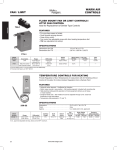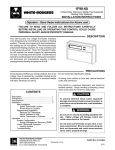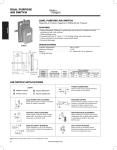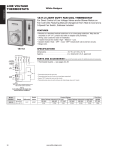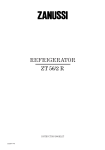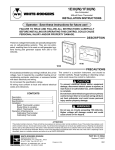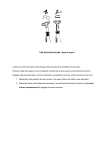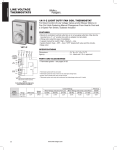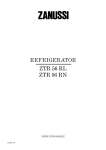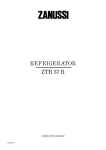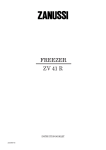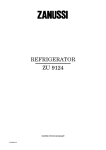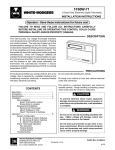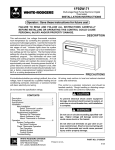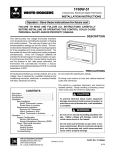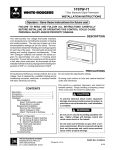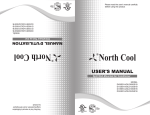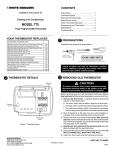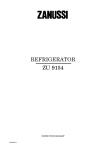Download white-rodgers 1e56(w) - Emerson Climate Technologies
Transcript
1E56(W) / 1F56(W) WHITE-RODGERS Low Voltage Heating/Cooling Thermostat With Sub-base For System and Fan Selection INSTALLATION INSTRUCTIONS Operator: Save these instructions for future use! FAILURE TO READ AND FOLLOW ALL INSTRUCTIONS CAREFULLY BEFORE INSTALLING OR OPERATING THIS CONTROL COULD CAUSE PERSONAL INJURY AND/OR PROPERTY DAMAGE. DESCRIPTION This low voltage thermostat is designed to provide convenient control of the heating/cooling system. To provide greater room comfort, the sensitive spiral bimetal is combined with an adjustable heating anticipator and a fixed cooling anticipator to provide maximum comfort. 1F56 1E56 If in doubt about whether your wiring is millivolt, line, or low voltage, have it inspected by a qualified heating and air conditioning contractor, electrician, or someone familiar with basic electricity and wiring. PRECAUTIONS This control is a precision instrument, and should be handled carefully. Rough handling or distorting components could cause the control to malfunction. ! CAUTION Do not exceed the specification ratings. All wiring must conform to local and national electrical codes and ordinances. To prevent electrical shock and/or equipment damage, disconnect electric power to system at main fuse or circuit breaker box until installation is complete. CONTENTS Description .............................................................................. Precautions ............................................................................. Specifications .......................................................................... Installation ............................................................................... Select Thermostat Location Route Wires to Location Attach Subbase to Wall Attach Thermostat to Subbase Operation & Maintenance ....................................................... Adjusting Heat Anticipator Calibrating Thermostat 1 1 2 2 5 ! WARNING Do not use on circuits exceeding 30 volts. Higher voltage will damage control and could cause shock or fire hazard. Do not short out terminals on gas valve or primary control to test. Short or incorrect wiring will burn out heat anticipator and could cause personal injury and/or property damage. ATTENTION! This product contains mercury. There will not be any exposure to mercury under normal conditions of use. This product may replace a unit which contains mercury. Do not open mercury cells. If a cell becomes damaged, do not touch any spilled mercury. Wearing non-absorbent gloves, take up the spilled mercury with sand or other absorbent material and place into a container which can be sealed. If a cell becomes damaged, the unit should be discarded. Mercury must not be discarded in household trash. When this unit or the unit it is replacing is to be discarded, place in a suitable container and return to us at WHITE-RODGERS. WHITE-RODGERS DIVISION EMERSON ELECTRIC CO. 9797 REAVIS RD., ST. LOUIS, MO. 63123 (314) 577-1300, FAX (314) 577-1517 9999 HWY. 48, MARKHAM, ONT. L3P 3J3 (905) 475-4653, FAX (905) 475-4625 PART NO. 37-5327E Printed in U.S.A. Replaces 37-5327D 9823 SPECIFICATIONS ELECTRICAL DATA Switch Rating: 24 VAC (30 VAC max.) Heating - 0.15 to 1.2 Amps Cooling - 0 to 1.5 Amps Switch Action: SPDT - Sealed mercury switch APPLICATIONS: The 1E56(W) / 1F56(W) is designed for use with • Standard heating and cooling systems • Two-transformer systems This thermostat CAN NOT BE USED with • Millivolt systems (self-generating systems that do not have a transformer or relay) • Three-wire zone valve systems • Multi-stage applications • Heat-pump systems • Electric heat furnace where thermostat must energize fan. Anticipator Rating: Heating - Adjustable from 0.15 to 1.2 Amps Cooling - Fixed 24 VAC THERMAL DATA Temperature Range: 10° to 32°C (50° to 90°F) Differential: 1/2°C (1°F) INSTALLATION 3. Probe for obstructions in partition before drilling 1/2" hole in wall at selected location. Take up quarter round and drill a small guide hole for sighting (see Fig. 1). From basement, drill 3/4" hole in partition floor next to guide hole. In basementless houses, drill 1/2" hole through ceiling and into partition from above (see Fig. 1). 4. Through this hole drop a light chain, or 6" chain attached to a strong cord. Snag cord in basement with hooked wire. In basementless houses, drop cord through hole in ceiling and down partitioning; snag cord at the thermostat location. 5. Attach thermostat wires to cord and pull thermostat wires through hole in wall so that 6" of wire protrudes. SELECT THERMOSTAT LOCATION Proper location insures that the thermostat will provide a comfortable home temperature. Observe the following general rules when selecting a location. 1. Locate thermostat about 5 ft. above the floor. 2. Install thermostat on a partitioning wall, not on an outside wall. 3. Never expose thermostat to direct light from lamps, sun, fireplaces or any temperature radiating equipment. 4. Avoid locations close to windows, adjoining outside walls, or doors that lead outside. 5. Avoid locations close to air registers or in the direct path of air from them. 6. Make sure there are no pipes or duct work in that part of the wall chosen for the thermostat location. 7. Never locate thermostat in a room that is warmer or cooler than the rest of the home, such as the kitchen. 8. Avoid locations with poor air circulation, such as behind doors or in alcoves. 9. The living or dining room is normally a good location, provided there is no cooking range or refrigerator on opposite side of wall. ! CAUTION To prevent electrical shock and/or equipment damage, disconnect electric power to system at main fuse or circuit breaker box until installation is complete. 1⁄2” hole for thermostat wire Stout cord with 6” chain attached ROUTE WIRES TO LOCATION Approximately 5 feet from floor Baseboard strip moulding NOTE 1⁄4” guide hole for sighting All wiring must conform with local and national electrical codes and ordinances. Quarter round removed 1. If an old thermostat is being replaced and is in a satisfactory location, and the wiring appears to be in good condition, use existing wiring. If in doubt, rewire. 2. If a new location is chosen or if this is a new installation, thermostat wiring must first be run to the location selected. 3⁄4” hole in floor of partition Hooked wire for snagging chain Figure 1. Routing thermostat wires 2 FAN NOTE AUTO All diagrams show the 1F56(W) horizontal model, turn subbase 90° for 1E56(W) vertical model. SYSTEM ON COOL OFF HEAT G RC ATTACH SUBBASE TO WALL 1. Pull wires through opening near centre of subbase and connect wires beneath terminal screws (see figs. 3 to 8). 2. Push excess wiring into wall and plug hole with fireresistant material (such as fiberglass insulation) to prevent drafts from affecting thermostat operation. 3. Position subbase over hole in wall and mark mounting hole locations on wall. 4. Drill mounting holes. 5. Fasten subbase loosely to wall, as shown, using two mounting screws. Place a level against bottom of subbase, adjust until level, and then tighten mounting screws to secure subbase. If holes in wall are too large and do not allow you to tighten subbase snugly, use plastic expansion plugs to secure subbase (see fig. 2). RH Y W Mounting screw Hole in wall KEEP THIS AREA CLEAR OF WIRES Mounting screw Figure 2. Thermostat subbase NOTE These typical wiring diagram show only the terminal identification and wiring hookup. Always refer to wiring instructions, provided by Equipment Manufacturer, for system hookup operation. Cool All wiring should be installed according to local and national electrical codes and ordinances. THERMOSTAT Fixed Cooling Anticipator Heat Bimetal Adjustable Heating Anticipator Captive Screws Fan Switch L COO OFF HEA T SUBBASE AUTO ON L COO OFF System Switch HEA T G RC Y RH W Figure 3. Thermostat /subbase diagram KEEP THIS AREA CLEAR OF WIRES! KEEP THIS AREA CLEAR OF WIRES! G G Field-installed jumper wire RC THERMOSTAT WIRING RC THERMOSTAT WIRING RH Y W RH Y JUMPER WIRE W Y Y G W RC G W RC Fan Relay Heating System RH RH SYSTEM NOTE SYSTEM Heating System RED jumper wire (provided with thermostat) must be connected between thermostat's RH and RC terminals for proper thermostat operation with this system. Hot 24 VAC 120 VAC Neutral TRANSFORMER Figure 4. Heating only, 2-wire, single transformer systems Hot 24 VAC Figure 5. Heat-only, 3-wire, single transformer systems 3 120 VAC Neutral TRANSFORMER KEEP THIS Field-installed AREA CLEAR OF WIRES! G RC jumper wire THERMOSTAT WIRING RH Y W JUMPER WIRE Y G W RC KEEP THIS AREA CLEAR OF WIRES! RH G RC SYSTEM NOTE RED jumper wire (provided with thermostat) must be connected between thermostat's RH and RC terminals for proper thermostat operation with this system. Cooling System Fan Relay THERMOSTAT WIRING Hot 24 VAC 120 VAC RH Neutral Y TRANSFORMER Figure 6. Cool only, 3-wire, single transformer systems Y G W RC W RH SYSTEM Hot KEEP THIS AREA CLEAR OF WIRES! G Field-installed jumper wire RC Cooling System Fan Relay Heating System 24 VAC 120 VAC Neutral HEATING TRANSFORMER THERMOSTAT WIRING Hot 24 VAC RH 120 VAC Neutral Y W COOLING TRANSFORMER Figure 8. Heat/cool, 5-wire, two-transformer systems JUMPER WIRE Y G W Cooling System Fan Relay Heating System RC RH SYSTEM NOTE RED jumper wire (provided with thermostat) must be connected between thermostat's RH and RC terminals for proper thermostat operation with this system. Hot 24 VAC 120 VAC Neutral TRANSFORMER Figure 7. Heat/cool, 4-wire, single transformer systems ! CAUTION Take care when securing and routing wires so they do not short to adjacent terminals or rear of thermostat. Personal injury and/or property damage may occur. ATTACHING THERMOSTAT TO SUBBASE FA TO N AU 1. Remove cover from thermostat base by gripping the base in one hand. Use the other hand to pull gently at the top or bottom of the cover. 2. Carefully remove the shipping protective packing from the switch. 3. Attach thermostat base to subbase, being sure that all captive screws are tightened snugly, since they serve as electrical connections between thermostat and subbase (see fig. 9). 4. Snap cover on thermostat and set temperature lever to desired set point. ON CO SYS OL TEM OF F HE AT Subbase Cover Thermostat Figure 9. Attach Thermostat to Subbase 4 OPERATION & MAINTENANCE This thermostat is easy to operate. Fig. 10 shows how the heating/cooling system and fan operate when the switches are in various positions. Use the system switch to select either heating or cooling, or to turn the heating/cooling system off. Use the fan switch to control fan operation. When the fan switch is in the AUTO position, the fan will cycle with the heating or cooling system (the fan will not run if the system switch is in the OFF position and the fan switch is in the AUTO position). When the fan switch is in the ON position, the fan will run continuously, regardless of system switch position (even if the system switch is set to OFF, the fan will run if the fan switch is in the ON position). Shows switch position FAN SYSTEM OPERATION AUTO ON COOL OFF HEAT No heating; no cooling; no fan No heating; no cooling; fan runs continuously Cooling system cycles from thermostat; fan runs continuously Cooling system and fan cycle from thermostat Heating system cycles from thermostat; fan cycles from fan control on furnace Heating system cycles from thermostat; fan runs continuously Figure 10. Subbase switching and thermostat/system operation ADJUSTING HEAT ANTICIPATOR CALIBRATING THERMOSTAT This thermostat has been carefully adjusted at the factory and should not require recalibration. ! CAUTION The adjustable heat anticipator WILL BURN OUT if 25 VAC is applied directly to the thermostat by shorting out the primary control during testing. This may cause personal injury and/or property damage. Due to environmental conditions, during normal operation there may be a few degrees difference between the indicator setting of the thermostat and actual room termperature. If the disagreement is appreciable, however, first make sure that the thermostat is properly located and leveled. Then, if recalibration still seems necessary, proceed as follows: This thermostat is equipped with an adjustable heat anticipator and was preset at the factory to provide satisfactory operation of the heating system under normal conditions. If additional adjustments are necessary, they may be made as follows (see Fig. 11): ! CAUTION To prevent electrical shock and/or equipment damage, disconnect electrical power to system until recalibration is complete. 1. Remove thermostat cover. 2. If heat cycle is too long, set heat anticipator to a slightly lower dial setting (1/2 division). 3. If heat cycle is too short, set heat anticipator to a slightly higher dial setting (1/2 division). 4. Replace thermostat cover. 1. The anticipator's heat may adversely affect thermostat recalibration. To prevent this, disconnect electrical power to thermostat at the furnace, main fuse, or breaker box. 2. Move temperature adjustment lever to a setting about 5° above room temperature. 3. Remove thermostat cover. Slip 7/32" wrench onto hex nut beneath bimetal. While holding temperature adjustment lever stationary, turn hex nut clockwise until mercury shifts to right end of tube (see Fig. 12). 4. Move temperature adjustment lever to lowest setting. 5. Replace thermostat cover. Wait 10 minutes for bimetal temperature to stabilize. Do not stand near the thermostat during this period as your breath and body heat will affect bimetal temperature. .3 .25 O NG ER YCLES .5 C L .4 .6 .8 1.2 Arrow points to the matched current rating of the primary control .2 .18 .15 Move this lever to adjust heat anticipator Figure 11. Anticipator Adjustment 5 6. Move temperature adjustment lever to correspond to actual room temperature. Then remove thermostat cover. 7. Slip 7/32" wrench onto hex nut. While holding temperature adjustment lever stationary, turn hex nut counterclockwise until mercury just barely shifts to left end of the tube (see Fig. 12). 8. Replace the thermostat cover and set temperature adjustment lever to desired temperature. Turn on electrical power to system. Bimetal 7/32" Calibration Wrench CALIBRATING COVER THERMOMETER The reading on the thermometer may vary slightly from the actual room temperature. However, if the thermometer reading on the cover is significantly different from the room temperature, calibrate the cover thermometer using the following procedure. 1. Remove thermostat cover. 2. Set cover on table near an accurate thermometer. 3. Allow at least ten minutes for the thermometers to adjust to room temperature. 4. If the thermometer readings are the same, no adjustments are necessary. 5. If the thermometer readings are different, insert a small screwdriver blade into the thermometer shaft on the back of the cover (see Fig. 13). Adjust until the cover thermometer matches the other thermometer. 6. Replace thermostat cover. Temperature Adjustment Lever Figure 12. Calibrating Thermostat Thermometer adjustment Back side of thermostat cover Figure 13. Calibrating Thermostat Thermometer WARRANTY INFORMATION THIS WARRANTY STATEMENT SUPERSEDES ALL WARRANTY STATEMENTS DATED PRIOR TO JANUARY 1, 1992. White-Rodgers Division of Emerson Electric Co, (“Seller”) warrants that its products purchased for resale (the “Products”) will be free from defects in material and workmanship under normal use and service for a period of twelve (12) months from date of installation. Seller’s obligation under this warranty, and Purchaser’s exclusive remedy for the breach thereof, shall be limited to, at Seller’s option, Seller’s replacement of any defective Product. F.O.B. Seller’s factory, or Seller’s issuance of a credit in the amount of the purchase price of such Product for resale as described below. Seller shall have the option of requiring the return of any defective Product, transportation charges prepaid, before recognizing any claim. This warranty shall not apply to any Product (1) which has been repaired or altered outside Seller’s factory or by other than Seller in any manner so as in Seller’s judgement, to affect its serviceability or proper operation; (2) which has been subjected by persons other than Seller to improper handling, operation, maintenance, repair or alteration; or (3) which has been subjected to misuse, negligence or accident. This warranty extends only to persons or organizations who purchase the Products for resale. THE FOREGOING CONSTITUTES SELLER’S SOLE RESPONSIBILITY UNDER THIS WARRANTY, AND PURCHASER’S EXCLUSIVE REMEDY FOR BREACH THEREOF. EXCEPT AS OTHERWISE EXPRESSLY SET FORTH IN THIS AGREEMENT, THERE ARE NO OTHER WARRANTIES, EXPRESS OR IMPLIED, WHETHER OF MERCHANTABILITY, FITNESS FOR A PARTICULAR PURPOSE, OR OTHERWISE. SELLER SHALL NOT BE LIABLE FOR ANY SPECIAL, INDIRECT, INCIDENTAL OR CONSEQUENTIAL DAMAGES IN CONNECTION WITH THE SALE, RESALE OR USE OF THE PRODUCTS. Complete warranty information and instructions for replacing/returning warranty products can be found in the White-Rodgers Product Catalogue, or by telephoning or writing to: WHITE-RODGERS DIVISION EMERSON ELECTRIC CANADA LIMITED 9999 HIGHWAY 48 MARKHAM, ONTARIO L3P 3J3 TELEPHONE: (905) 475-4653 FAX: (905) 475-4625 WARRANTY INFORMATION FOR CONSUMERS When you purchase a White-Rodgers Division product, it is typically for replacement of a device which has failed on existing residential or commercial equipment, or a component of new equipment purchased for modernization. While our warranty does not extend to you, your contractor or dealer is protected by a one-year product warranty from White-Rodgers. Your supplier can rely on a nearby White-Rodgers wholesaler for prompt credit or replacement. 1E56(W) / 1F56(W) WHITE-RODGERS Thermostat à basse tension de chauffage et climatisation avec socle de commande du système et du ventilateur INSTRUCTIONS D’INSTALLATION Utilisateur : conservez ces instructions pour vous y référer au besoin ! SI VOUS NE LISEZ PAS ATTENTIVEMENT CES INSTRUCTIONS AVANT D’INSTALLER ET D’UTILISER LA COMMANDE, VOUS RISQUEZ DE CAUSER DES BLESSURES ET DES DOMMAGES MATÉRIELS. DESCRIPTION Ce thermostat à basse tension a été conçu comme commande pratique des systèmes de chauffage et climatisation. Dans le but de vous offrir le plus grand confort possible, le bilame sensible en spirale est couplé à deux éléments anticipateurs, l’un réglable pour le chauffage et l’autre fixe pour la climatisation. 1F56 1E56 Si vous n’êtes pas certain de la tension du câblage de votre système (soit en millivolts, à basse tension ou à la tension du réseau), faites inspecter celui-ci par un électricien, un entrepreneur agréé en chauffage et climatisation ou une personne qui a des connaissances de base en électricité et en câblage. Ne dépassez pas les charges nominales. Tout le câblage doit être conforme aux codes et règlements locaux et nationaux qui régissent les installations électriques. PRÉCAUTIONS Cette commande est un instrument de précision qui doit être manipulé avec soin. Elle peut se détraquer si elle est manipulée de façon négligente ou si des composantes sont déformées. ! ATTENTION Afin de prévenir les chocs électriques et les dommages matériels pendant l’installation, couper l’alimentation électrique au panneau de distribution principal. ! TABLE DES MATIÈRES Description ............................................................................... Précautions .............................................................................. Spécifications ........................................................................... Installation ................................................................................ Choix du site pour le thermostat Acheminement du câblage au site Installation du socle sur le mur Installation du thermostat sur le socle Mode d’emploi et entretien ....................................................... Réglage de l’anticipation de chauffage Étalonnage du thermostat AVERTISSEMENT 1 1 2 2 Ne vous servez pas de cette commande sur des circuits dont la tension dépasse 30 volts. La surtension risque d’endommager la commande et pose un risque d’électrocution et d’incendie. 5 Ne court-circuitez pas les bornes du robinet de gaz ou de la commande principale pour effectuer des essais. Les court-circuit et câblage inadéquat endommagerent l’anticipateur de chauffage et risquent d’entraîner des blessures et des dommages matériels. ATTENTION ! Cet appareil contient du mercure. Il n’y a aucun risque d’exposition lorsque l’appareil est utilisé normalement. Cet appareil peut en remplacer un autre qui, lui, contient du mercure. N’ouvrez pas les cellules de mercure. Si une cellule est endommagée, ne touchez pas au mercure qui s’en échappe. Enfilez des gants étanches et nettoyez le mercure avec du sable ou une autre substance absorbante, puis placez le matériel contaminé dans un contenant qui peut être fermé hermétiquement. Si une cellule est endommagée, l’appareil en entier doit être jeté. Ne pas jeter de mercure avec les ordures ménagères. Si vous devez jeter cet appareil ou celui qu’il remplace, placez-le dans un contenant convenable et faites-le parvenir à WHITE-RODGERS. WHITE-RODGERS DIVISION EMERSON ELECTRIC CO. 9797 REAVIS RD., ST. LOUIS, MO. 63123 (314) 577-1300, Télécopieur (314) 577-1517 9999 HWY. 48, MARKHAM, ONT. L3P 3J3 (905) 475-4653, Télécopieur (905) 475-4625 PIÈCE NO 37-5327E Imprimé au É.-U.A. Remplace 37-5327D 9820 SPÉCIFICATIONS FICHE ÉLECTRIQUE Charges du commutateur : 24 V c.a. (maxi 30 V c.a.); Chauffage : 0,15 à 1,2 A; Climatisation : 0 à 1,5 A. Commutation : Unipolaire bidirectionnelle (SPDT) à bulle de mercure scellé. Anticipation : Chauffage : Réglable de 0,15 à 1,2 A; Climatisation : Fixe à 24 V c.a. FICHE THERMIQUE Plage des points de consigne : 10°C à 32°C (50°F à 90°F). Différentiel : 1/2°C (1°F). APPLICATIONS : Le 1E56(W) / 1F56(W) a été conçu pour servir avec : • Les systèmes ordinaires de chauffage et climatisation; • Les systèmes à deux transformateurs. Ce thermostat NE PEUT PAS SERVIR avec : • Les systèmes millivolts (systèmes sans transformateur ni relais) • Les systèmes à trois fils à soupapes de zone; • Les systèmes à plusieurs étages; • Les systèmes à thermopompe; • Les appareils de chauffage électriques dont le thermostat doit mettre le ventilateur sous tension. INSTALLATION CHOIX D’UN SITE POUR LE THERMOSTAT 3. Assurez-vous qu’il n’y a pas d’obstacle dans le mur avant d’y percer un trou de 1/2" à l’endroit choisi. Enlevez ensuite le quart-de-rond et percez un petit trou de guidage (figure 1). Au sous-sol, percez un trou de 3/4" dans le plancher de la cloison, à côté du trou de guidage. Dans les bâtiments sans sous-sol, percez le trou de 1/2" dans le plafond, entre les parois de la cloison (figure 1). 4. Passez par le trou que vous avez percé dans le mur une chaînette ou une corde solide avec une chaînette de 6” attachée au bout. Accrochez la chaînette au sous-sol à l’aide d’un crochet de fil de fer. Dans les maisons sans soussol, passez la chaînette par le trou percé dans le plafond et accrochez-le par celui que vous avez percé dans le mur. 5. Attachez le câblage du thermostat à la corde et faites-le passer par le trou dans le mur; laissez pendre 6" de câblage. Pour que le thermostat puisse assurer une température ambiante confortable, il doit être installé dans un site adéquat. Choisissez le site en tenant compte des recommandations suivantes : 1. Placez le thermostat environ à 1,5 m (5 pieds) du sol. 2. Installez le thermostat sur une cloison intérieure et non sur un mur extérieur. 3. N’exposez pas le thermostat directement à la lumière de lampes, aux rayons du soleil, ni à la chaleur d’un foyer ou d’un radiateur. 4. Évitez les endroits près d’une fenêtre ou encore d’un mur ou d’une porte extérieurs. 5. Évitez les endroits qui sont près des bouches d’air ou dans la trajectoire de l’air qui en émane. 6. Assurez-vous qu’il n’y a pas de tuyaux ni de conduites dans le mur à proximité du site du thermostat. 7. N’installez jamais le thermostat dans une pièce qui est habituellement plus chaude ou plus froide que le reste du domicile, comme la cuisine, par exemple. 8. Évitez les endroits où la circulation d’air se fait mal, comme les alcôves et l’arrière des portes. 9. La salle à diner et le salon sont généralement des endroits propices s’il n’y a pas de cuisinière ou de réfrigérateur adossé au mur derrière le thermostat. ! ATTENTION Afin de prévenir les chocs électriques et les dommages matériels pendant l’installation, couper l’alimentation électrique au panneau de distribution principal . Trou de 1⁄2" pour le câblage du thermostat ACHEMINEMENT DU CÂBLAGE AU SITE NOTE Corde solide attachée à une chaîne de 6" Tout le câblage doit être conforme aux codes et règlements locaux et nationaux qui régissent les installations électriques. 1. Si vous remplacez un thermostat dont l’emplacement est adéquat et si le câblage semble être en bon état, servezvous du câblage déjà en place. En cas d’incertitude, câblez à neuf. 2. Si vous choisissez un nouvel emplacement ou encore si vous installez à neuf, vous devrez commencer par acheminer le câblage au site choisi. Environ 5 pieds Plinthe Trou de guidage de 1⁄4" Quart-de-rond enlevé Trou de 3⁄4" dans le plancher de la cloison Fil de fer replié pour accrocher la chaîne Figure 1. Acheminement du câblage au site 2 FAN NOTE AUTO Tous les schémas illustrent le modèle horizontal 1F56(W). Pour le modèle vertical 1E56(W), tournez le socle de 90° de façon à l’orienter à la verticale. SYSTEM COOL OFF HEAT ON G RC INSTALLATION DU SOCLE SUR LE MUR 1. Faites passer les fils dans l’ouverture au centre du socle et raccordez les fils sur les bornes à vis (figures 3 et 8). 2. Repoussez dans le mur le surplus de fil et bouchez le trou avec un produit ignifuge (comme de la mousse isolante en fibre de verre) afin d’empêcher que des courants d’air n’affectent le fonctionnement du thermostat. 3. Placez le socle du thermostat sur le mur, devant le trou de passage des câbles, et reportez sur le mur l’emplacement des trous de montage. 4. Percez les trous de montage. 5. À l’aide des deux vis de montage, fixez lâchement le socle de la façon illustrée. Placez un niveau sous le socle et ajustez celui-ci pour qu’il soit de niveau. Serrez ensuite les vis pour fixer le socle. Si les trous de montage sont trop grands et ne vous permettent pas de fixer solidement le socle, servez-vous des chevilles de plastique pour l’assujettir (figure 2). RH Y W Trou dans Vis de montage le mur ÉCARTEZ LES FILS DE CET ENDROIT Vis de montage Figure 2. Socle du thermostat NOTE Le schéma de câblage typique illustre uniquement l’identification des bornes et le raccordement des fils. Pour raccorder le système, référez-vous toujours aux directives de câblage fournies par le fabricant de l’équipement. Climat. Tout le câblage doit être conforme aux codes et règlements locaux et nationaux qui régissent les installations électriques. Anticipateur fixe de Climat. THERMOSTAT Chauf. Bilame Anticipateur de chauf. réglable Vis Captives L COO OFF HEA T SOCLE AUTO ON L COO OFF Commutateur du Ventilateur Commutateur du System HEA T G RC Y RH W Figure 3. Schéma du thermostat et du socle ÉCARTEZ LES FILS DE ÉCARTEZ LES FILS DE CET ENDROIT G CET ENDROIT G Cavalier raccordé sur place RC RC CÂBLAGE DU THERMOSTAT CÂBLAGE DU THERMOSTAT RH RH Y Y G W RC Y W CAVALIER Y RH NOTE Sous tension 24 V c.a. G W RC RH SYSTÈME SYSTÈME Système du chauf. W Pour assurer le bon fonctionnement de l'appareil avec ce type système, le cavalier ROUGE (foumi avec le thermostat) doit relier les bornes RH et RC du thermostat 120 V c.a. Neutre TRANSFORMATEUR Relais vent. Système du Chauf. Sous tension 24 V c.a. 120 V c.a. Neutre TRANSFORMATEUR Figure 4. Chauffage seulement à 2 fils et un transformateur Figure 5. Chauffage seulement à 3 fils et un transformateur 3 ÉCARTEZ LES FILS DE G CET ENDROIT Cavalier raccordé RC sur place CÂBLAGE DU THERMOSTAT RH Y W ÉCARTEZ LES FILS DE CET ENDROIT CAVALIER Y G W RC G RC CÂBLAGE DU THERMOSTAT RH SYSTÈME NOTE Pour assurer le bon fonctionnement de l'appareil avec ce type système, le cavalier ROUGE (foumi avec le thermostat) doit relier les bornes RH et RC du thermostat Relais vent. Système du chauf. RH Sous tension 24 V c.a. 120 V c.a. Y W Neutre TRANSFORMATEUR Y G W RC RH SYSTÈME Figure 6. Climatisation seulement à 3 fils et un transformateur Sous tension Système du Relais Climat. vent. Système du Chauf. 24 V c.a. 120 V c.a. Neutre ÉCARTEZ LES FILS DE CET ENDROIT G TRANSFORMATEUR DU CHAUFFAGE Cavalier raccordé sur place RC Sous tension 24 V c.a. 120 V c.a. CÂBLAGE DU THERMOSTAT Neutre TRANSFORMATEUR DU CLIMATISATION RH Y Figure 8. Chauffage et climatisation à 5 fils et deux transformateurs W CAVALIER Y G W RC RH SYSTÈME NOTE Pour assurer le bon fonctionnement de l'appareil avec ce type système, le cavalier ROUGE (foumi avec le thermostat) doit relier les bornes RH et RC du thermostat Système du Climat. Relais Système du vent. Chauf. Sous tension 24 V c.a. 120 V c.a. Neutre TRANSFORMATEUR Figure 7. Chauffage/Climatisation à 4 fils et un transformateur ! ATTENTION Lorsque vous acheminez et fixez le câblage, assurezvous qu’aucun fil ne court-circuite une borne adjacente ou l’arrière du thermostat. Ceci pourrait causer des blessures et des dommages matériels. INSTALLATION DU THERMOSTAT SUR LE SOCLE FA TO N AU ON CO SYS OL TEM OF F HE AT 1. Pour détacher le couvercle du thermostat, saisissez le thermostat d’une main et, de l'autre, tirez doucement le haut ou le bas du couvercle. 2. Retirez soigneusement l’emballage qui protège le commutateur. 3. Fixez le thermostat sur le socle. Assurez-vous que les vis captives sont vissées à fond, car elles servent de raccordement électrique entre le thermostat et le socle (figure 9). 4. Engagez le couvercle sur le thermostat et placez la manette de réglage du point de consigne au niveau désiré. Socle Thermostat Couvercle Figure 9. Installation du thermostat sur le socle 4 MODE D’EMPLOI ET D’ENTRETIEN Ce thermostat est facile d’usage. La figure 10 illustre le fonctionnement du système de chauffage ou de climatisation en fonction du réglage des commutateurs. Le commutateur de système permet, d’une part, de choisir entre le chauffage et la climatisation et, d’autre part, de mettre l’appareil de chauffage ou de climatisation hors tension. Quant au commutateur de ventilateur, il sert à commander ce dernier : réglé à la position AUTO, le ventilateur se mettra sous tension et hors tension en même temps que le systéme de chauffage ou de climatisation (le ventilateur ne démerrera jamais si le commutateur de systéme est à la position OFF [ARRÊT] alors que le commutateur de ventilateur est à la position AUTO). Lorsque le commutateur de ventilateur est réglé à la position ON (MARCHE), le ventilateur fonctionnera sans arrêt, peu importe la position du commutateur de systéme (même si ce dernier est à la position OFF [ARRÊT]). Position du commutateur FAN SYSTEM FONCTIONS AUTO ON COOL OFF HEAT Pas de chauffage; pas de climatisation; ventilateur à l'arrêt Pas de chauffage; pas de climatisation; le ventilateur est continuellement en marche Le système de climatisation est commandé par le thermostat; le ventilateur est continuellement en marche Le système de climatisation et le ventilateur sont commandés par le themostat Le système de chauffage est commandé par le thermostat; le ventilateur est commandé par l'appareil de chauffage Le système de chauffage est commandé par le thermostat; le ventilateur est continuellement en marche Figure 10. Fonctionnement du systéme et du ventilateur en fonction de la position des commutateurs de socle RÉGLAGE DE L’ANTICIPATION DE CHAUFFAGE ÉTALONNAGE DU THERMOSTAT Le thermostat a été réglé avec soin en usine. Il ne devrait pas être nécessaire de l’étalonner. En usage normal, les conditions atmosphériques peuvent entraîner une différence de quelques degrés entre le point de consigne et la température ambiante de la pièce. Si cette différence est significative, assurez-vous d’abord que le thermostat est de niveau et que son emplacement a été bien choisi. Si l’étalonnage semble encore nécessaire, veuillez procéder de la façon suivante : ! ATTENTION L’élément anticipateur réglable SERA GRILLÉ si vous raccordez le thermostat directement sur du courant de 25 V c.a. en court-circuitant la commande principale lors d’essais. Ceci peut entraîner des blessures et des ! ATTENTION Le thermostat est doté d’un anticipateur réglable de chauffage. Il a été réglé à l’usine de façon à commander adéquatement le système de chauffage utilisé dans des conditions normales. Si un réglage s'avère nécessaire, procédez de la façon suivante (figure 11). 1. Détachez le couvercle du thermostat. 2. Si les cycles de chauffage sont trop longs, diminuez légèrement le réglage de l'élément anticipateur (1/2 graduation). 3. Si les cycles de chauffage son trop courts, augmentez légèrement le réglage de l'élément anticipateur (1/ 2 graduation). 4. Replacez le couvercle du thermostat. Afin de prévenir les chocs électriques et les dommages matériels pendant l’installation, couper l’alimentation électrique au panneau de distribution principal . 1. La chaleur de l’élément anticipateur peut affecter l’étalonnage du thermostat. Dans le but d’éviter ce problème, coupez l’alimentation en provenance de l’appareil de chauffage ou du panneau de distribution électrique. 2. Placez la manette de réglage du point de consigne environ à 5° au-dessus de la température ambiante. 3. Détachez le couvercle du thermostat. Glissez un clé anglaise de 7/32" sur l’écrou hexagonal situé sous le bilame. Tout en maintenant en place la manette de régalge, tournez l’écrou à droite jusqu’à ce que le mercure se déplace vers la droite du tube (figure 12). 4. Placez la manette de réglage du point de consigne à son niveau le plus bas. 5. Replacez le couvercle du thermostat. Attendez 10 minutes que la température du bilame se stablise. Ne vous tenez pas à proximité du thermostat durant cette période, car votre souffle et la chaleur de votre corps pourraient affecter la température du bilame. .3 .25 O NG YCLES .5 ER C L .4 .6 .8 1.2 La flèche indique le courant correspondant de la commande principale .2 .18 .15 Déplacez cette manette pour régler l’anticipation Figure 11. Réglage de l’anticipation 5 6. Placez la manette de réglage du point de consigne à la température de la pièce, puis détachez le couvercle du thermostat. 7. Glissez la clé anglaise de 7/32" sur l’écrou hexagonal situé sous le bilame. Tout en maintenant en place la manette, tournez l’écrou à gauche jusqu’à ce que le mercure se déplace vers la gauche du tube (figure 12). 8. Replacez le couvercle sur le thermostat et réglez le point de consigne au niveau souhaité. Rétablissez le courant qui alimente le système. Bilame Manette de réglage du point de consigne Clé anglaise de 7/32 ÉTALONNAGE DU THERMOMÈTRE DU COUVERCLE Il est possible que la température indiquée par le thermomètre soit légèrement différente de la température ambiante. Si cette différence est significative, vous pouvez étalonner le thermomètre du couvercle de la façon suivante : 1. Détachez le couvercle du thermostat. 2. Placez le couvercle sur une table près d'un thermomètre juste. 3. Attendez au moins dix minutes pour que les thermomètres s’ajustent à la température ambiante. 4. Si les deux thermomètres indiquent la même température, alors aucun réglage n’est nécessaire. 5. Si les deux thermomètres ne concordent pas, introduisez la pointe d’un petit tournevis plat dans l’axe du thermomètre, qui est situé à l’arrière du couvercle (figure 13). Réglez le thermomètre du couvercle pour le faire concorder avec l’autre. 6. Replacez le couvrcle sur le thermostat. Figure 12. Étalonnage du thermostat Réglage du thermomètre Arrière du couvercle du thermostat Figure 13. Étalonnage du thermomètre du thermostat RENSEIGNEMENTS DE GARANTIE CET ENONCE DE GARANTIE REMPLACE TOUT ENONCE DE GARANTIE DATE D’AVANT LE 1er JANVIER 1992. White-Rodgers, une division de Emerson Electric Co., (“Le vendeur”) garantit que ses produits achetés pour la revente (”Les produits”) sont exempts de tout défaut matériel et de maind’oeuvre pour une période d’usage et d’entretien normaux d’une durée de douze (12) mois à compter de la date d’installation. L’obligation du vendeur, et le seul recours de l’acheteur, en vertu de cette garantie, se limite, au choix du vendeur, au remplacement de tout produit défectueux, franc de port de l’usine du vendeur, ou à l’émission d’un crédit pour le prix d’achat du produit pour revente, tel que décrit ci-bas. Le vendeur se réserve le droit d’exiger le retour de tout produit défectueux, frais de transport payés d’avance, avant d’accepter une réclamation. Cette garantie ne s’applique à aucun produit qui (1) a été réparé ou altéré à l’extérieur de l’usine du vendeur ou par autre que le vendeur de façon telle que, de l’avis du vendeur, l’appareil ne peut plus fonctionner ni être réparé adéquatement; (2) a été manipulé, utilisé, réparé ou altéré incorrectement par tout autre que le vendeur; ou (3) a subi un emploi abusif, de la négligence ou un accident. Cette garantie ne s’applique qu’aux personnes physiques et morales qui achètent ce produit pour la revente. CE QUI PRECEDE REPRESENTE LA SEULE RESPONSABILITE DU VENDEUR EN VERTU DE CETTE GARANTIE, AINSI QUE LE SEUL RECOURS DE L’ACHETEUR. A MOINS D’ETRE EXPRESSEMENT DEFINI AILLEURS DANS CETTE ENTENTE, IL N’Y A PAS D’AUTRE GARANTIE, EXPLICITE OU IMPLICITE, QUANT A L’ETAT DE VENTE, A L’APTITUDE A UNE TACHE, OU A TOUT AUTRE CRITERE. LE VENDEUR N’EST RESPONSABLE D’AUCUN DOMMAGE SPECIAL, INDIRECT OU FORTUIT EN RAPPORT AVEC LA VENTRE, LA REVENTE OU L’UTILISATION DE CES PRODUITS. Des renseignements complets sur la garantie ainsi que des directives sur le remplacement et le retour de produits sous garantie se retrouvent dans le catalogue de produits White-Rodgers, et peuvent être obtenus en téléphonant ou en écrivant à: DIVISION WHITE-RODGERS EMERSON ELECTRIC CANADA LIMITÉE 9999 HWY48 MARKHAM, ONTARIO L3P 3J3 TÉLÉPHONE: (905) 475-4653 TÉLÉCOPIEUR: (905) 475-4625 RENSEIGNEMENTS DE GARANTIE POUR LES CONSOMMATEURS Lorsque vous achetez un produit de la Division White-Rodgers, celui-ci sert généralement à remplacer un appareil d’une installation résidentielle ou commerciale qui a fait défaut, ou comme composante d’équipement neuf acheté pour moderniser une installation. Bien que notre garantie ne s’applique pas à vous, votre entrepreneur ou votre marchand est protégé par la garantie d’un an sur les produits de White-Rodgers. Votre fournisseur peut se fier sur le grossiste White-Rodgers le plus près pour obtenir rapidement un crédit ou un appareil de remplacement.












